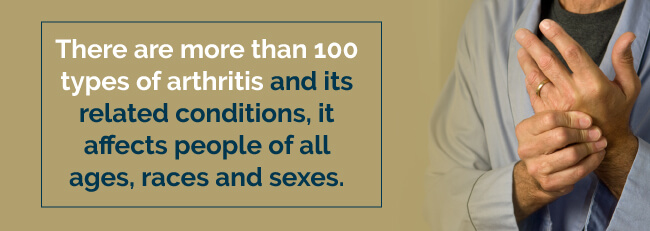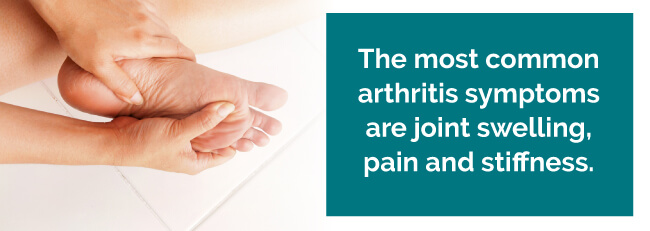For patients suffering from painful inflammation characteristic of arthritis, medical cannabis is a great option to help keep that inflammation under control. Research has suggested that medical cannabis can help manage not just the common symptoms of arthritis, but also the side effects of having a long-term debilitating illness, like mood disorders and lack of appetite. Learn more about arthritis, the symptoms of arthritis, how medicinal cannabis can help alleviate common symptoms of arthritis and how arthritis can start finding relief with medical marijuana.
Medical marijuana is a natural, affordable alternative to traditional medicines used to treat arthritis, which also lacks the side effects found in conventional drugs. Increasingly, many patients who are afflicted with arthritis have instead opted to use medical marijuana to relieve their symptoms. These patients have experienced excellent results, including less pain, reduced use of other medications and improved movement, through their use of medical weed.
Find A Doctor Find A Dispensary
Experts believe certain strains of marijuana can specifically help those who have arthritis. Strains of medical cannabis for arthritis include Pennywise, a form of indica that has mild psychoactive effects. Harlequin, which is a sativa, is very popular because it provides a relaxing sensation without making the user feel sedated. Cannatonic is a hybrid strain that provides a very relaxing, mellow high, while AC/DC is a sativa that does not alter perception or mood.
Once you receive a recommendation from your doctor to receive medical marijuana for arthritis, have a talk with a professional at your local dispensary. They can direct you toward the best strains to ease your discomfort.
Recent research has shown medicinal marijuana can be an effective alternative arthritis treatment. For example, in a 2005 article published in the Journal of Neuroimmunology, researchers J. Ludovic and Takashi Yamamura explained cannabinoids might be a consideration for patients for the treatment of inflammatory diseases, such as arthritis.
Additionally, Ethan Russo, MD, senior medical adviser at the Cannabinoid Research Institute, explained the following in his 2005 “Arthritis and Medical Marijuana” brochure:
“Science has now revealed that the THC [tetrahydrocannabinol] element of cannabis is an effective pain-killing (analgesic) agent, and CBD (cannabidiol) has particularly immunomodulatory advantages as an antagonist of tumor necrosis factor-alpha, which supports benefits in the rheumatoid arthritis treatment.”
A 2009 study in the Journal of Opioid Management discovered 80 percent of medical pot users in an American pain clinic used cannabis to treat muscle and tissue pain. Also, 65 percent of medical pot users in Canada reported they use medical cannabis to treat severe arthritis, according to Everyday Health.

To date, many states have approved various types of arthritis as a qualifying condition for medical marijuana.
Marijuana is useful for joint pain and inflammation. It’s also often used for enhancing your appetite, treating insomnia and for elevating your mood. If you feel tired due to your condition, pot can offer you a pick-me-up whenever it’s needed.
Do you think cannabis will help alleviate the pain that you experience from arthritis? If so, you may be interested in enrolling as a medical marijuana patient in your state. At the time of writing, 33 U.S. states have an approved medical marijuana program.
It’s important to familiarize yourself with the medical marijuana laws in your state before pursuing a cannabis treatment plan.
If your state permits cannabis access for arthritis, connect with a certified physician who can help you enroll. They’ll diagnose your condition and provide you with the guidance and recommendations you need. Many states require patients to sign up for a medical marijuana I.D. card. With this document, they can obtain their cannabis supply from an accredited marijuana dispensary located in their state.
Now you know more about how medical pot can help alleviate your arthritis symptoms, but how can you take it? If you’re new to marijuana, you no doubt have many questions about the best route of delivery. Let’s look at some of the most popular ways to take medical pot to help you make up your mind. You may find you want to experiment with any of the following ways of taking cannabis until you find one that suits you.
Smoking a cannabis joint is often the first method of delivery that comes to mind when we think of pot. However, when you take cannabis for health reasons, you may not want to introduce smoke into your lungs. Although smoking gives you fast relief from your symptoms, it can irritate your lungs and cause permanent damage to your respiratory system. If you do wish to smoke marijuana, start off with a small hit to see how it affects you.
You put topicals directly onto your skin to relieve joint pain and inflammation. With topical medical marijuana, you receive the benefits of pot, but without a high.
You can make or buy all manner of edibles with marijuana, and they’re often a more palatable choice for inexperienced pot users. They can take a while to kick in, though, so you need to be wary of taking too much. You also need to keep your edibles out of reach of pets and children.
Vaping protects your lungs from the high heat of smoking, which causes less lung damage. Vaping units can be expensive and need periodic recharging. As with other delivery methods, start small and build up gradually.
Pot absorbs rapidly through your colon. The effects tend to be long-lasting, too. You might opt for suppositories if you don’t like the idea of vaping or smoking, or if you have trouble swallowing. You need to keep pot suppositories in the fridge.
Tinctures and sprays absorb through your mouth. It’s easy to control your dosage with these. However, they take a while to kick in. You can take the spray or tincture directly into your mouth for fast relief. You can also add these to your food, but that slows the rate of absorption. Tinctures and sprays can be on the expensive side, so you may want to consider other options if you need to use them regularly.
You can purchase transdermal timed-release patches that have a similar concept to nicotine patches. You place these on a hairless, clean skin surface. The active ingredients go straight into your bloodstream. Patches are, therefore, useful for full-body pain relief. In contrast, topicals are useful for localized pain management.
You can eat marijuana raw, or add it to smoothies and drinks. To get the full medicinal benefit from fresh cannabis, you should consume the leaves immediately after blending them. When you eat or drink cannabis in its raw form, you get its full benefits. One downside is that you need a large and constant supply of leaves. It can also be difficult to determine the exact dosage. You also won’t have immediate symptomatic relief, as the pot needs to travel through your digestive system.
Marijuana no longer has the stigma it once had. There are many different strains of marijuana on the market, each of which has different benefits. The vast choice dispensaries offer can be confusing to the novice user. With this in mind, we have created this quick guide, categorized by symptom, to get you started.
If inflammation and joint pain get you down, the following strains can help:

When you’re feeling discomfort from your painful and achy joints, your appetite is often one of the first things to suffer. Pot is notorious for giving people “the munchies.” Take a look at these strains that can help you get your appetite back on track:
Chronic pain can take its toll on your emotional and psychological well-being. The following strains are useful if you’re looking for a gentle way to enhance your mood:
You need sleep to heal your body. Suffering from insomnia is an unfortunate side effect of arthritis, but you don’t need to put up with it. The following strains can help you drop off into a pain-free slumber:
Marijuana is increasingly becoming a preferred treatment form for arthritis because of its lack of adverse effects. When patients take cannabis, they’re more likely to experience multi-symptom relief without acquiring new discomforts in the process.
Any unwanted effects of marijuana are usually minor and resolve once the medical marijuana supply leaves the patient’s body. As noted, unwanted effects from cannabis are not common and the mild side effects that may occur are often a preferred alternative to the pain generated by arthritis.
Some of the potential side effects of using marijuana to treat arthritis include increased appetite, mood changes and lethargy. Talk with your doctor about whether medical marijuana is the right choice for your lifestyle and needs.
Fortunately, there are many different medication options currently available to patients dealing with the side effects of arthritis. However, it’s vital to learn more about this health complication before deciding on the best treatment plan for your needs.
Arthritis is a common, yet not well-understood, condition. According to the Arthritis Foundation, there are more than 100 types of the disease and its related conditions. Arthritis affects people of all ages, races and sexes, although it tends to occur most often as you age and is also more common in women.

The term arthritis means joint inflammation. It affects your connective tissue, joints and the tissues surrounding them.
There are many different types of arthritis. The following are some of the most common:
Osteoarthritis is the most common type of arthritis. It occurs when your cartilage wears away. Bone rubs against bone, and you experience stiffness, pain and swelling. Your joints can lose strength, and your pain can become long-term over time.
Your risk of getting osteoarthritis increases if you have the following factors:
You may be able to prevent osteoarthritis by staying at a healthy weight, avoiding repetitive movements and injuries and being active.
Metabolic arthritis patients have elevated levels of uric acid in the body. If you have this type of arthritis, you can’t get rid of your elevated uric acid levels quickly enough. It builds up and forms needle-like crystals in the joints.
Metabolic arthritis sufferers experience sudden bouts of intense joint pain or gout. Gout may become chronic and can result in long-term disability and pain if you don’t reduce your uric acid levels.
Inflammatory arthritis is the result of your immune system mistakenly attacking your joints. It causes inflammation and potential joint erosion. Your body may sustain damage as a consequence of the disease. Both psoriatic arthritis and rheumatoid arthritis (RA) are examples of inflammatory arthritis.
According to the Arthritis Foundation, researchers think a combination of environmental and genetic factors triggers this autoimmunity. Smoking is just one environmental risk factor that may be a trigger for inflammatory arthritis if you have a particular genetic makeup.
A fungus, bacterium or virus can sometimes enter your joints and result in inflammation. Organisms that may do this include:
Early diagnosis is key to treat infectious arthritis. Often, antibiotic treatment can help. However, for some people, the condition can become chronic.
Arthritis can afflict people of any age, sex, ethnicity and health status. Because there are over 100 varieties of this health complication, many different factors are at play when discussing the root cause of this issue.
For many patients, arthritis occurs over time as the cartilage protecting their joints wears down. This is why osteoarthritis — one of the most common forms of arthritis — is most notably observed in seniors and older patients.
Another common cause of arthritis stems from autoimmune disorders. When the body’s immune system mistakenly attacks tissue in the body, it causes a negative impact on the soft tissue in the joints that are responsible for healthy cartilage maintenance.
Certain risk factors, such as joint injuries or impact, obesity, age and genetics can also play a role in one’s likelihood of contracting this condition.
People have suffered from arthritis since ancient times, according to News Medical. Texts from as early as 4500 BCE refer to the disease. One from 123 CE describes a list of symptoms that seem similar to the condition we know today.
The disease was rare before the 1600s. It spread across the world during the Age of Exploration. Arthritis received its name in 1859. The first recognized description of RA was by French doctor Augustin Jacob Landre-Beauvais in 1800. British rheumatologist Dr. Alfred Baring Garrod came up with the name rheumatoid arthritis in 1859. William Musgrave described the symptoms of rheumatoid arthritis in De Arthritide Symptomatica in 1715.
The paintings of Flemish artist Peter Paul Rubens in the 16th century sometimes showed people with symptoms of RA.
The Centers for Disease Control and Prevention published the following statistics on arthritis:
The most common arthritis symptoms are joint swelling, pain and stiffness. You may find your range of motion decreases, and that you have red skin around the affected joints. You could find your symptoms are worse in the morning.

If you have rheumatoid arthritis, you tend to lose your appetite and feel tired. There’s also the risk of anemia and fever when you have RA. If you don’t get your RA condition treated, your joints may look deformed.
Advances in treatment and early diagnosis mean if you have arthritis, your quality of life is likely to be far better than previous generations. While this may be true, a 2011 study in Arthritis Care & Research found measures of mental and physical health can be as many as two to three times worse in people living with arthritis. Findings of the study included:
Arthritis effects are different from person to person. They depend on the type and severity of your illness. The good news is that medical cannabis for arthritis could help you live a more normal and fulfilling life.
Currently, health care professionals use more than 100 medications and drugs in the treatment of arthritis. Many of these drugs, however, can cause serious side effects.
There are five main classes of drugs used to treat this condition — non-steroidal anti-inflammatory drugs (NSAIDs), analgesics, corticosteroids, disease-modifying anti-rheumatic drugs (DMARDs) and biologics. Here is a brief description of each, along with some information about the potential side effects:
A doctor typically recommends these drugs before stronger medications. There are over-the-counter NSAIDs such as Aleve and Advil, but most medications in this class are more potent and require a prescription. Prescription NSAIDs include etodolac, flurbiprofen, naproxen and others. They usually produce relatively minor side effects such as constipation, dry mouth and headache, but they can also lead to abdominal cramping, rapid weight gain, numbness and tingling of the extremities and more.
Analgesics are medications designed to relieve pain. You can find over-the-counter versions such as Tylenol, as well as powerful prescription drugs that are in the opioid class of medications, such as hydrocodone. Opioids are effective pain relievers, but they also carry a high risk of overdose, as well as abuse, by people who do not have a legitimate need for them. Any overdose can lead to severe health complications and even death.
Corticosteroids are synthetic medications that mimic the functions of the hormone cortisol, which controls inflammation. These drugs can be very beneficial, but they can also lead to severe side effects if taken in either high doses or over an extended period. Possible side effects include mood changes, memory problems, fluid retention, high blood pressure and more.
Prescription drugs in this classification include Arava, Plaquenil, Xeljanz and others. They are slow-acting medications that can take weeks to begin showing results, and designed to lessen the chances of permanent damage to the joints. They also work to slow the progression of arthritis. Patients have reported serious issues when taking DMARDs, such as eye problems, upset stomach, liver damage and birth defects.
Biologics, also known as biologic response modifiers, are very similar to DMARDs. They target specific cells and proteins linked to inflammatory arthritis. Physicians administer most biologics intravenously. Side effects include fever, nausea, chills, headache and an increased risk for infections.
Medical marijuana can offer you a real lifeline when it comes to treating your arthritis symptoms. Everyone is unique and faces their own distinct set of symptoms. By talking to a marijuana doctor about your symptoms, you can learn about the best course of weed treatment that works well for you as an individual. If you wish to know more about cannabis and arthritis and improve your quality of life, you can search for a medical marijuana doctor or dispensary today.
Find A Doctor Find A Dispensary